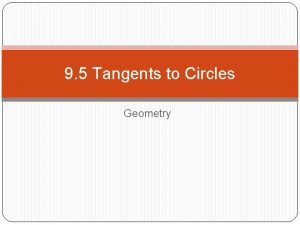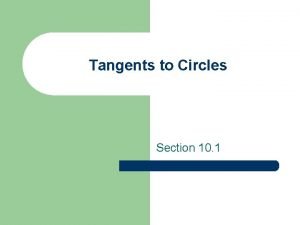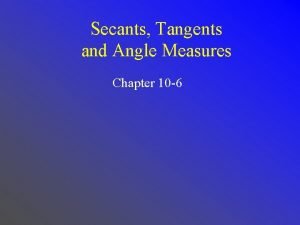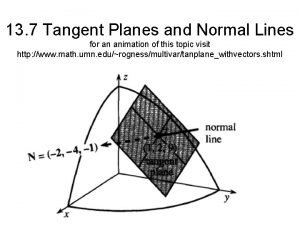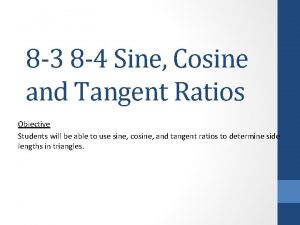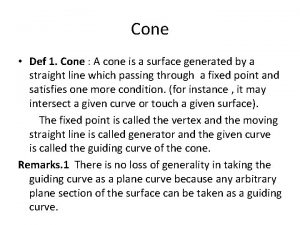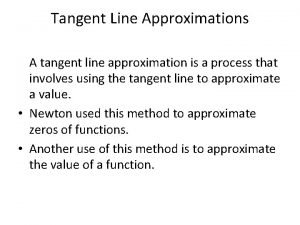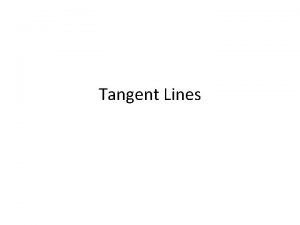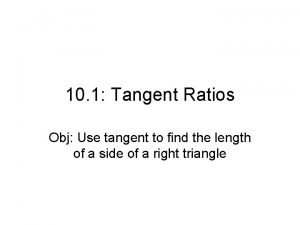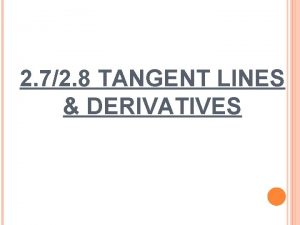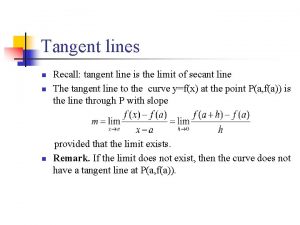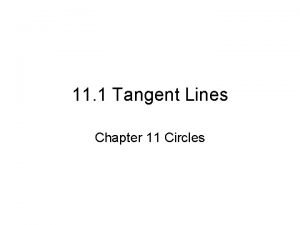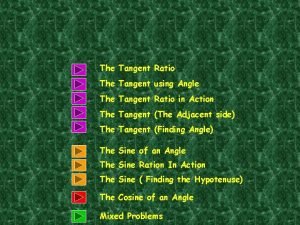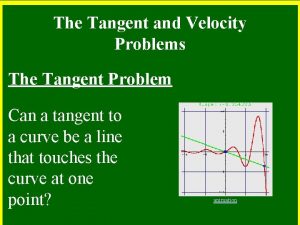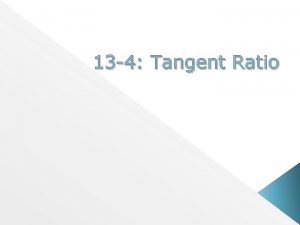14 4 Tangent Planes Differential Elements Tangent Planes
















- Slides: 16

14. 4 Tangent Planes Differential Elements

Tangent Planes The tangent plane to the surface S (with equation z = f (x, y)), at the point P is defined to be the plane that contains both tangent lines T 1 and T 2. At the point P(x 0, y 0 , z 0 ), the slope of the tangent T 1 is fx(x 0, y 0) and the slope of the tangent T 2 is fy(x 0, y 0) We know that any plane passing through the point P(x 0, y 0, z 0) has an equation of the form A(x – x 0) + B(y – y 0) + C(z – z 0) = 0 And we can prove that this equation can be rewritten: z – z 0 = a(x – x 0) + b(y – y 0) Where: a= fx(x 0, y 0) And b= fy(x 0, y 0) 2

Tangent Plane equation: Remember this formula! 3

Example 1 Find the tangent plane to the elliptic paraboloid z = 2 x 2 + y 2 at the point (1, 1, 3). Solution: Let f (x, y) = 2 x 2 + y 2. Then: fx(x, y) = 4 x fx(1, 1) = 4 fy(x, y) = 2 y fy(1, 1) = 2 Then formula [2] gives the equation of the tangent plane at (1, 1, 3) as: or z – 3 = 4(x – 1) + 2(y – 1) z = 4 x + 2 y – 3 4

Tangent Planes Figure (a) shows the elliptic paraboloid and its tangent plane at (1, 1, 3) that we found in Example 1. In parts (b) and (c) we zoom in toward the point (1, 1, 3) by restricting the domain of the function f (x, y) = 2 x 2 + y 2. Notice that the more we zoom in, the flatter the graph appears and the more it resembles its tangent plane. The elliptic paraboloid z = 2 x 2 + y 2 appears to coincide with its tangent plane as we zoom in toward (1, 1, 3). 5

Linear Approximations 6

Linear Approximations In Example 1 we found that an equation of the tangent plane to the graph of the function f (x, y) = 2 x 2 + y 2 at the point (1, 1, 3) is z = 4 x + 2 y – 3. Therefore, the linear function of two variables: L(x, y) = 4 x + 2 y – 3 is a good approximation to f (x, y) when (x, y) is near (1, 1). L(x, y) is called the linearization of f at (1, 1) and the approximation: f (x, y) ≈ 4 x + 2 y – 3 is called the linear approximation of f at (1, 1). 7

Linear Approximations In general, the equation of the tangent plane to the graph of a function f of two variables at the point (a, b, f (a, b)) is z = f (a, b) + fx(a, b)(x – a) + fy(a, b)(y – b) The linear function whose graph is this tangent plane, namely L(x, y) = f (a, b) + fx(a, b)(x – a) + fy(a, b)(y – b) is called the linearization of f at (a, b) and the approximation: f (x, y) ≈ f (a, b) + fx(a, b)(x – a) + fy(a, b)(y – b) is called the linear approximation of f at (a, b). 8

Differentials 9

Differentials For a differentiable function of two variables, z = f (x, y), we define the differential dz, also called the total differential, by: Sometimes the notation df is used in place of dz. 10

Geometric interpretation of dz: Figure B is the three-dimensional counterpart of Figure A • dz represents the change in height of the tangent plane, • z represents the change in height of the surface z = f (x, y) when (x, y) changes from (a, b) to (a + x, b + y). Figure A Figure B 11

Example 2 (a) If z = f (x, y) = x 2 + 3 xy – y 2, find the differential dz. (b) If x changes from 2 to 2. 05 and y changes from 3 to 2. 96, compare the values of z and dz. Solution: (a) Definition 10 gives: (b) Putting x = 2, dx = 0. 05, y = 3, and dy = – 0. 04, we get: dz = [2(2) + 3(3)]0. 05 + [3(2) – 2(3)](– 0. 04) = 0. 65 The actual increment of z is: z = f (2. 05, 2. 96) – f (2, 3) = [(2. 05)2 + 3(2. 05)(2. 96) – (2. 96)2] – [22 + 3(2)(3) – 32] = 0. 6449 Notice that z ≈ dz but dz is easier to compute! 12

Functions of Three or More Variables 13

Functions of Three or More Variables If w = f (x, y, z), then the increment w of w is: w = f (x + x, y + y, z + z) – f (x, y, z) the differential dw is: 14

Example 3 The dimensions of a rectangular box are measured to be 75 cm, 60 cm, and 40 cm, and each measurement is correct to within 0. 2 cm. Use differentials to estimate the largest possible error when the volume of the box is calculated from these measurements. Solution: If the dimensions of the box are x, y, and z, its volume is V = xyz and so: 15

Example 3 – Solution cont’d We are given that | x | 0. 2, | y | 0. 2, and | z | 0. 2. To estimate the largest error in the volume, we therefore use dx = 0. 2, dy = 0. 2, dz = 0. 2 and x = 75, y = 60, and z = 40: V ≈ d. V = (60)(40)(0. 2) + (75)(60)(0. 2) = 1980 cm 3 So an error of only 0. 2 cm in each dimension could lead to an error of approximately 1980 cm 3 in the calculated volume! This may seem like a large error, but it’s only about 1% of the volume of the box. 16
 40²+30²
40²+30² Internal tangent vs external tangent
Internal tangent vs external tangent 10-6 secants tangents and angles
10-6 secants tangents and angles Tangent planes and normal lines
Tangent planes and normal lines Name the elements of a folktale
Name the elements of a folktale Atomic elements vs molecular elements
Atomic elements vs molecular elements Http //elements.wlonk.com/elements table.htm
Http //elements.wlonk.com/elements table.htm What are the performance elements of drama
What are the performance elements of drama Four main features of a folktale
Four main features of a folktale Elements and sub elements
Elements and sub elements Integrals involving powers of secant and tangent
Integrals involving powers of secant and tangent Practice 9-1 the tangent ratio
Practice 9-1 the tangent ratio What is sine cosine and tangent
What is sine cosine and tangent General equation of cone
General equation of cone Identify the parts of the circle
Identify the parts of the circle Tangent line approximation
Tangent line approximation Ratio for tangent
Ratio for tangent
